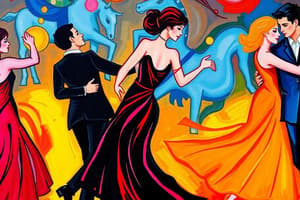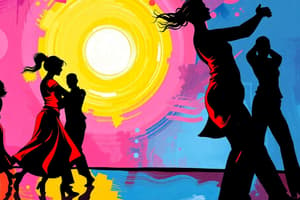Podcast
Questions and Answers
What are the two principal schools of ballroom dancing?
What are the two principal schools of ballroom dancing?
- Social and Competitive
- International and American
- Smooth and Rhythm
- Standard and Latin (correct)
Which dance is the oldest of all ballroom dances?
Which dance is the oldest of all ballroom dances?
- Foxtrot
- Tango
- Quickstep
- Viennese Waltz (correct)
Which dance is believed to be of African-American origin?
Which dance is believed to be of African-American origin?
- Tango
- Quickstep
- Rumba
- Foxtrot (correct)
Which dance is the national dance of Brazil?
Which dance is the national dance of Brazil?
Which dance includes Cuban motions through knee-strengthening, figure-eight hip rotation, and swiveling foot action?
Which dance includes Cuban motions through knee-strengthening, figure-eight hip rotation, and swiveling foot action?
Which dance was developed as an offshoot of danzón, the national dance of Cuba, in the late 1930s?
Which dance was developed as an offshoot of danzón, the national dance of Cuba, in the late 1930s?
Which dance was invented in the 1920s as a combination of faster foxtrot and the Charleston?
Which dance was invented in the 1920s as a combination of faster foxtrot and the Charleston?
Which dance is mostly performed only in competitions and originated from Spain and its dramatic bullfights?
Which dance is mostly performed only in competitions and originated from Spain and its dramatic bullfights?
Which style of ballroom dance is more popularly referred to as the ten dances of Standard and Latin?
Which style of ballroom dance is more popularly referred to as the ten dances of Standard and Latin?
Flashcards
Ballroom Dance
Ballroom Dance
A set of partner dances enjoyed for both social and competitive purposes, often on stage, film, and television. Two main schools of ballroom dance are identified: American and International.
Viennese Waltz
Viennese Waltz
A dance originally from France, the oldest known ballroom dance. Known for its smooth, gliding motion and graceful turns.
Tango
Tango
A passionate Argentine dance, originating in Buenos Aires. Pairs dance in both open and closed embraces, expressing strong emotions through their movements.
Foxtrot
Foxtrot
Signup and view all the flashcards
Pasodoble
Pasodoble
Signup and view all the flashcards
Standard/Smooth Dances
Standard/Smooth Dances
Signup and view all the flashcards
Latin Dances
Latin Dances
Signup and view all the flashcards
Collegiate Ballroom
Collegiate Ballroom
Signup and view all the flashcards
Ballroom Dance Levels
Ballroom Dance Levels
Signup and view all the flashcards
Study Notes
Overview of Ballroom Dance
-
Ballroom dance is a set of partner dances enjoyed both socially and competitively around the world.
-
Ballroom dancing is widely enjoyed on stage, film, and television.
-
The term "ballroom dancing" may refer to almost any recreational dance with a partner, but two principal schools have emerged.
-
Exhibitions and social situations that feature ballroom dancing may also include additional partner dances such as Lindy Hop, Night Club Two Step, Night Club Swing, Bachata, Country Two Step, and regional favorites.
-
The first authoritative knowledge of the earliest ballroom dances was recorded toward the end of the 16th century.
-
Competitive ballroom dance competitions are regulated by each country in its own way, with about 30 countries competing regularly in international competitions.
-
Competitors dance at different levels based on their ability and experience, with levels split into two categories: syllabus and open.
-
Medal evaluations for amateurs enable dancers' individual abilities to be recognized according to conventional standards.
-
Collegiate ballroom is a part of the ballroom world dedicated to college students.
-
"Ballroom dance" refers most often to the ten dances of Standard and Latin, though the term is also often used interchangeably with the five International Ballroom dances.
-
Other dances sometimes placed under the umbrella "ballroom dance" include nightclub dances such as Lindy Hop, West Coast swing, nightclub two-step, hustle, salsa, and merengue.
-
Standard/Smooth dances are normally danced to Western music, and couples dance counter-clockwise around a rectangular floor following the line of dance.Overview of Ballroom Dance Styles
-
Viennese waltz originated in France in 1559 and is the oldest of all ballroom dances.
-
Tango originated in Buenos Aires in the late 19th century and is danced in both open and closed embraces.
-
Foxtrot is an American dance, believed to be of African-American origin, and can be danced at slow, medium, or fast tempos.
-
Quickstep is an English dance and was invented in the 1920s as a combination of faster foxtrot and the Charleston.
-
Pasodoble originated from Spain and its dramatic bullfights and is mostly performed only in competitions.
-
Spanish bolero was developed in the late 18th century out of the seguidilla and saw many classical adaptations.
-
Cuban bolero is a combination of many dances such as slow salsa, patterns of rhumba, and rise and fall technique of waltz and foxtrot.
-
Samba is the national dance of Brazil and is danced with a slight bounce which is created through the bending and straightening the knee.
-
Rumba came to the United States from Cuba in the 1920s and includes Cuban motions through knee-strengthening, figure-eight hip rotation, and swiveling foot action.
-
Mambo was developed as an offshoot of danzón, the national dance of Cuba, in the late 1930s.
-
Cha Cha was developed by Enrique Jorrín in the early 1950s, as a slower alternative to Mambo.
-
East Coast Swing was established by Arthur Murray and others only shortly after World War II.
-
There are two main ballroom dance style classifications: International Style and American Style.
Studying That Suits You
Use AI to generate personalized quizzes and flashcards to suit your learning preferences.




